The AMD Ryzen 9 3950X Review: 16 Cores on 7nm with PCIe 4.0
by Dr. Ian Cutress on November 14, 2019 9:00 AM ESTCPU Performance: Encoding Tests
With the rise of streaming, vlogs, and video content as a whole, encoding and transcoding tests are becoming ever more important. Not only are more home users and gamers needing to convert video files into something more manageable, for streaming or archival purposes, but the servers that manage the output also manage around data and log files with compression and decompression. Our encoding tasks are focused around these important scenarios, with input from the community for the best implementation of real-world testing.
All of our benchmark results can also be found in our benchmark engine, Bench.
Handbrake 1.1.0: Streaming and Archival Video Transcoding
A popular open source tool, Handbrake is the anything-to-anything video conversion software that a number of people use as a reference point. The danger is always on version numbers and optimization, for example the latest versions of the software can take advantage of AVX-512 and OpenCL to accelerate certain types of transcoding and algorithms. The version we use here is a pure CPU play, with common transcoding variations.
We have split Handbrake up into several tests, using a Logitech C920 1080p60 native webcam recording (essentially a streamer recording), and convert them into two types of streaming formats and one for archival. The output settings used are:
- 720p60 at 6000 kbps constant bit rate, fast setting, high profile
- 1080p60 at 3500 kbps constant bit rate, faster setting, main profile
- 1080p60 HEVC at 3500 kbps variable bit rate, fast setting, main profile
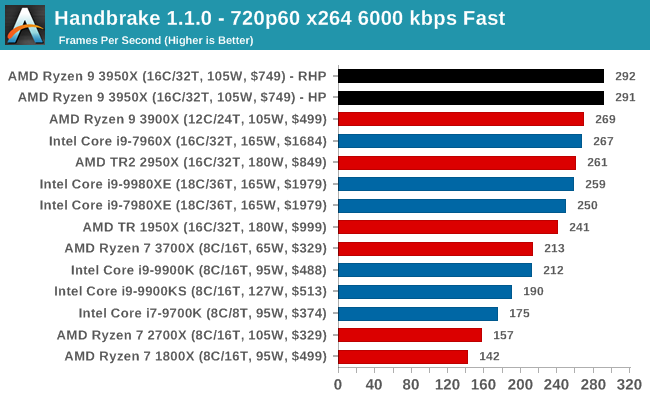
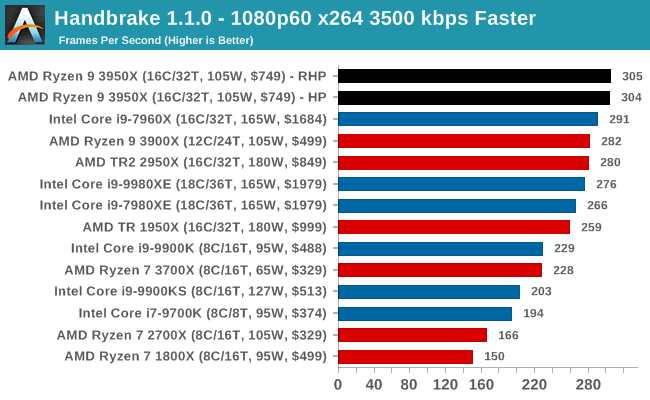
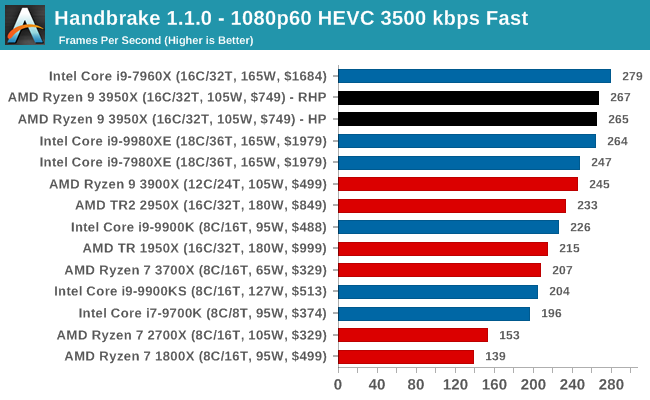
7-zip v1805: Popular Open-Source Encoding Engine
Out of our compression/decompression tool tests, 7-zip is the most requested and comes with a built-in benchmark. For our test suite, we’ve pulled the latest version of the software and we run the benchmark from the command line, reporting the compression, decompression, and a combined score.
It is noted in this benchmark that the latest multi-die processors have very bi-modal performance between compression and decompression, performing well in one and badly in the other. There are also discussions around how the Windows Scheduler is implementing every thread. As we get more results, it will be interesting to see how this plays out.
Please note, if you plan to share out the Compression graph, please include the Decompression one. Otherwise you’re only presenting half a picture.

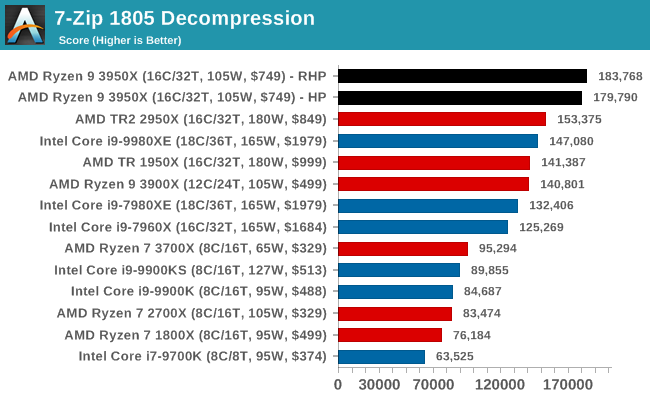
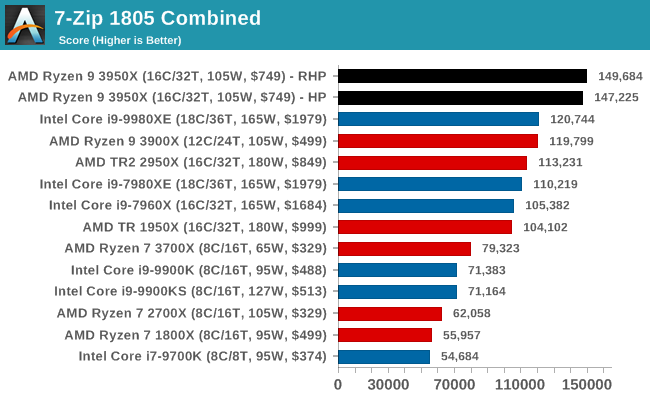
Again, AMD's 16-core Zen 2 hardware is breezing past Intel's 18-core Skylake-Refresh family. Even with the added frequency that Cascade Lake will bring, it would be hard to see it able to topple AMD here.
WinRAR 5.60b3: Archiving Tool
My compression tool of choice is often WinRAR, having been one of the first tools a number of my generation used over two decades ago. The interface has not changed much, although the integration with Windows right click commands is always a plus. It has no in-built test, so we run a compression over a set directory containing over thirty 60-second video files and 2000 small web-based files at a normal compression rate.
WinRAR is variable threaded but also susceptible to caching, so in our test we run it 10 times and take the average of the last five, leaving the test purely for raw CPU compute performance.
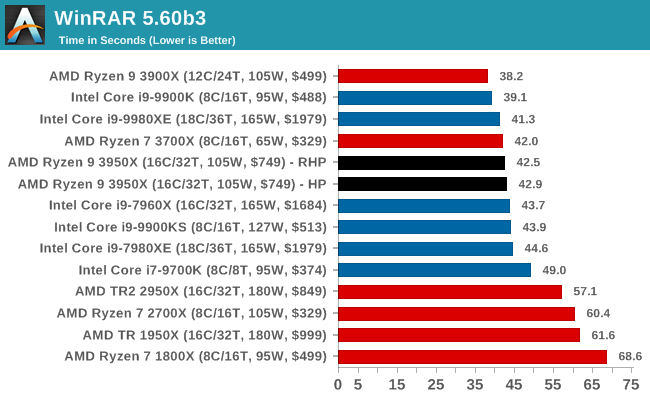
As a variable threaded workload, WinRAR also probes memory performance. Both the 3700X and 3800X beat the 3950X here.
AES Encryption: File Security
A number of platforms, particularly mobile devices, are now offering encryption by default with file systems in order to protect the contents. Windows based devices have these options as well, often applied by BitLocker or third-party software. In our AES encryption test, we used the discontinued TrueCrypt for its built-in benchmark, which tests several encryption algorithms directly in memory.
The data we take for this test is the combined AES encrypt/decrypt performance, measured in gigabytes per second. The software does use AES commands for processors that offer hardware selection, however not AVX-512.
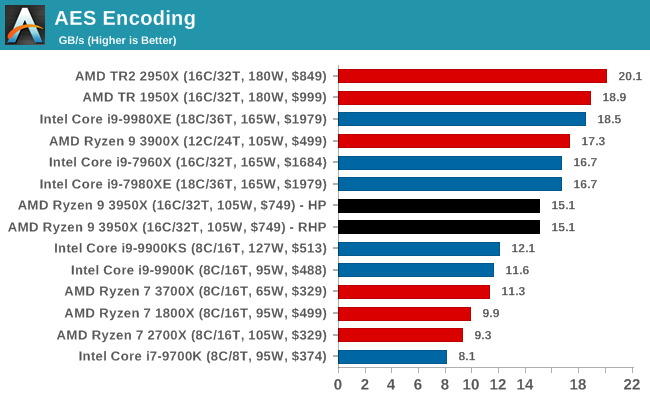
Our AES benchmark seemed a bit off - I would suggest we're being memory limited here but the Ryzen 9 3900X scores a lot higher over the 3950X. More investigation needed.










206 Comments
View All Comments
Spunjji - Thursday, November 14, 2019 - link
In theory it might be. In practice, they're still only able to make mobile CPUs with 4 cores or less on it.Orange_Swan - Thursday, November 14, 2019 - link
Nah, they've got at least one 6core/12thread, 15/25w mobile CPU, the Core i7-10710URetycint - Thursday, November 14, 2019 - link
That's 14nm. All Intel's 10nm processors so far have been limited to 4 core Ice Lake U processorsSmartcom5 - Friday, November 15, 2019 - link
If, and that's the whole issue here since a while now, IF Intel's 10nm would be working after all.Sure enough, that's a requirement which still needs to be fulfilled yet. The best process – no matter how oh so advanced it is going to be (on paper) – is worth exactly no·thing if it ain't working. Then, even a (on paper inferior) node is superior, since it at least meets a crucial condition; It's working (already).Thus, it isn't anymore. They relaxed it quite a bit in 2017 to make it work, that's it.
Intel's actual 10nm which spawned Ice Lake isn't the same as it was before, that's why it's coined 10nm+. It's actually less dense than Intel's initial and original-10nm which brought Cannonlake – density was toned down, it's more like ~12nm now.
Interestingly TSMC on its current 7nm N7-process already archives virtually the very same density Intel failed to archive on their initial 10nm-process back then – while their current 10nm+, which has a toned-down density from initially 2.7× down to only some 2.0—2.2× (depending on what sources you're willing to trust), is rumoured to rather equal some 12nm-ish alike process instead of being closer to any initial Intel'ian 10nm.
So while Intel somehow failed, others archived the same density-goals Intel was trying to do for years, to no greater avail – and those others where even on track as scheduled most of the time. Thus, TSMC already fabs on a process which would equal Intel's very initial 10nm-process, which never really saw any greater light of day, bar that known i3-8121U (well, and that m3-8114Y of course, ... you don't know a thing about it, okay?).
GraveNoX - Thursday, November 14, 2019 - link
Yes, they will launch 10nm and 7nm on the same day so you have the freedom to choose which version of the chip you want.Oliseo - Thursday, November 14, 2019 - link
"Based on my imagination Intel will destroy AMD"Santoval - Thursday, November 14, 2019 - link
It is meaningless to compare Intel's 7nm parts, which will be released in 2021 assuming NO delays (thus more realistically in 2022+) with AMD's current 7nm parts. If you were going for a "node for node" comparison that is even more meaningless, because Intel's 7nm node will be equivalent to TSMC's 4nm or 5nm node in transistor density (I have read numbers predicting ~185 million transistors per mm^2 for TSMC's 5nm node and ~200nm MTr/mm^2 for Intel's 7nm node). TSMC's 5nm node will almost certainly be released before Intel's 7nm node by the way.Regarding Intel's 10nm node parts, while Sunny Cove appears to have a higher IPC than Zen 2 Intel's 10nm parts suffer from much lower clocks which have eaten away all or almost all the IPC gains. This is why Intel have not announced an Ice Lake-S/H release and intend to replace it with Comet Lake-S/H. S/H parts require high clocks, which cannot be provided by Intel's 10nm+ node due to very low yields at high clocks. Only low power Ice Lake-U/Y parts and Ice Lake Xeons will be released. Why? Because these parts have lower clocks.
More or less the same thing might be repeated with Tiger Lake, in 2H 2020, which would mean that Intel are not very confident of fixing their 10nm node issues even with their 10nm++ node variant. It is rumored that there will be no Tiger Lake-S/H parts and Rocket Lake-S/H will take their place. What's Rocket Lake? A 14nm+++++++ part but with a new μarch (Sunny or Willow Cove cores and a Gen11 or Gen12 iGPU).
Santoval - Thursday, November 14, 2019 - link
edit : "and ~200 MTr/mm^2 for Intel's 7nm node".Targon - Thursday, November 14, 2019 - link
Didn't TSMC start 5nm risk production a month or so ago?John_M - Monday, November 25, 2019 - link
Yes, they did.